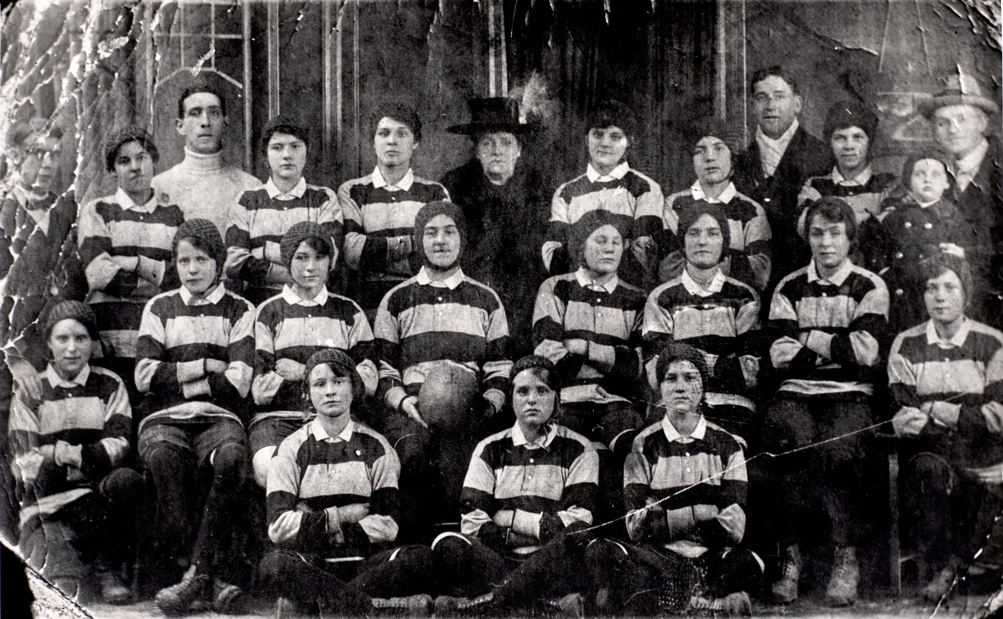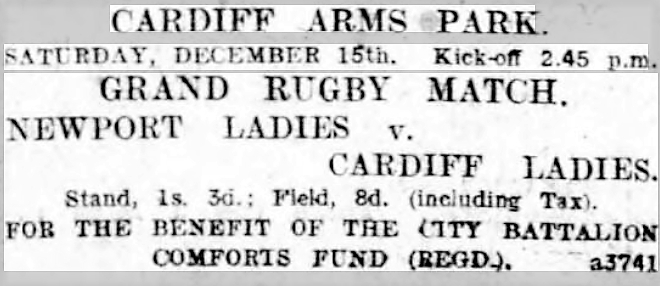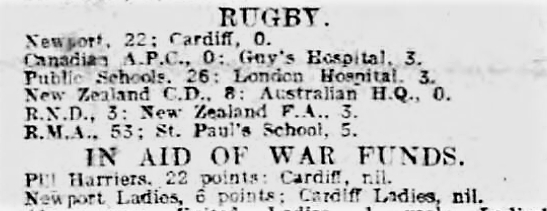The now-famous photograph of the Cardiff Ladies XV in the Cardiff clubhouse is believed to be the oldest known image of a women’s rugby team. It can be dated precisely, because it was taken on 15th December 1917, just before the players went out to meet their Newport rivals at the Arms Park. The encounter between Cardiff and Newport that day was therefore a significant event and it has long enjoyed a strong claim to being the first genuine game of women’s rugby played in the public arena.

There had been occasional attempts in the 1880s to stage women’s rugby, but these were organised solely as titillating money-making exhibitions. Participants were mocked and even assaulted and, on at least one occasion, a game in Hull had to be abandoned following a pitch invasion. The Cardiff v Newport match, however, was quite different. This was a properly organised game of rugby, played to its conclusion in front of an appreciative crowd at a major rugby venue.
As with all civilian matches during the First World War, the proceeds were donated to charity. Cardiff RFC abandoned fixtures at the outbreak of war in August 1914, but by 1916-17 they began running a regular unofficial wartime XV to support various local and military charities. The women’s match was played in aid of the “Comforts Fund” for the men of the “Cardiff City Battalion”. The choice of this charity was hardly surprising. The 16th Battalion Welsh Regiment had close links with Cardiff RFC, not least through many of its personnel, which even included its Commanding Officer, Fred Smith who had been club vice-captain in 1908-9 and 1909-10. It is also likely that several of the Cardiff Ladies XV had spouses, sweethearts or brothers serving in the battalion.

The Cardiff players were mostly employees of Hancock’s brewery, while Newport’s team was drawn from the staff of Lysaghts iron works. Unfortunately, the names of most of the participants were not recorded. The best known member of the Cardiff team is Maria Lillian Eley (or Maria Evans as she then was in 1917). Born on 12th January 1900, she was therefore only seventeen when she turned out at full back against Newport. Maria lived to 106 and in March 2000, at the age of 100, she was guest of honour of Cardiff RFC at the match against Caerphilly at the Arms Park, where she was introduced to the crowd. Maria was apparently one of the recommendations for the first woman to be inducted into World Rugby’s Hall of Fame.
When asked in an interview with the Penarth Times, how she accounted for her longevity, she replied, “rugby”. Maria added, “We loved it. It was such fun with us all playing together on the pitch, but we had to stop when the men came back from the war, which was a shame. Such great fun we had.” Evidently then, Cardiff Ladies played on several occasions. There is a brief reference in the press to them playing in Treorchy in May 1918 but no details of any of their other matches have yet been discovered.
In the photograph, Maria Eley can be seen second from the left in the middle row (first seated). On her left is Lilian Eva Rees (also aged seventeen), while sitting alongside Lilian in the centre with the ball is the captain E. Kirton. The older lady in the middle of the back row wearing a hat is Bessie (“Ma”) Rosser, the proprietor of the Grand Hotel in Westgate Street, where both teams changed for the match.

Details of the game remain elusive, apart from the result, which saw Newport victorious by six points to nil. The English rugby journalist, E H D Sewell, commented on it in his column in the Illustrated Sporting and Dramatic News the following Saturday. He couldn’t have been present at the match because he incorrectly reported the score as 22-0. This was, in fact, the result of the Newport v Cardiff men’s match held in Newport on the same day. His prediction about the future of women’s rugby was wrong too. Despite not witnessing the game at the Arms Park, he still felt able to comment disparagingly:
“There is little likelihood, happily, of Ladies Rugby football ever becoming popular. Indeed, it is a most unedifying spectacle, calculated to lower the prestige of the game. In the ‘eighties there was a “Ladies” Rugby team that was to go on tour, but it was a ghastly sight and it is a pity anyone has thought of anything like a repetition. The fairer sex has come to stay in many spheres of life, but certainly not on the Rugby football field.”
Despite Sewell’s comments, however, it has recently been discovered that December 1917 was not the first time that women had played rugby at the Arms Park. According to a contemporary report in the Western Mail, there had been an even earlier women’s match at the ground, three months before on 29th September 1917. This time though, there were no Cardiff-based participants, as the two teams were comprised of “girl munitions workers from Newport”. As these were termed the “Wasps” and the “Whites”, it seems likely that the “Wasps” were wearing the traditional Newport strip of black and amber.
Thousands attended at the Arms Park to watch this earlier game, which ended in a 3-3 draw. Evidently they were not disappointed. Demonstrating a much more open-minded and positive attitude than Edward Sewell, the Western Mail’s columnist wrote: ”A wonderful display of scrimmaging, running, passing, and kicking was given by the girls, who pleased the spectators immensely by their vimful and earnest measures.”
And very much closer to the action than Sewell had ever been and, therefore, in a much better position to sit in judgement on the women’s game, was R. Pollock, a very experienced WRU match official. He was happy to declare afterwards that he had refereed many a worse game between male teams.
Why this contest involving teams from Newport was held at the Arms Park is a mystery. The two sides are known to have met again in Barry in March 1918 in front of 4,000 spectators, so perhaps the Arms Park game was one of a series they held around south Wales. However, until details of any earlier fixture materialise, the Arms Park can still lay claim to being the venue of the first recorded women’s match.
That the female representatives of their arch rivals were able to mount a successful rugby event at the Arms Park clearly posed a challenge to Cardiff’s rugby community. It is intriguing that the Western Mail concluded its match report by revealing, “A ladies match between Cardiff and Newport munitions workers is now proposed.” Was this actually the genesis of the game played the following December and of the famous photograph now in the Cardiff Rugby Museum collection?
The fact that at least four women’s matches were reported in the south-east Wales press during 1917 and 1918 suggests that there may have been rather greater enthusiasm for women’s rugby locally than has previously been realised. Perhaps there are more – and earlier? – games waiting to be discovered.
Gwyn Prescott
Thanks to John and Adrienne Davey for providing information about Maria Eley. Adrienne is Maria’s granddaughter.

There had been occasional attempts in the 1880s to stage women’s rugby, but these were organised solely as titillating money-making exhibitions. Participants were mocked and even assaulted and, on at least one occasion, a game in Hull had to be abandoned following a pitch invasion. The Cardiff v Newport match, however, was quite different. This was a properly organised game of rugby, played to its conclusion in front of an appreciative crowd at a major rugby venue.
As with all civilian matches during the First World War, the proceeds were donated to charity. Cardiff RFC abandoned fixtures at the outbreak of war in August 1914, but by 1916-17 they began running a regular unofficial wartime XV to support various local and military charities. The women’s match was played in aid of the “Comforts Fund” for the men of the “Cardiff City Battalion”. The choice of this charity was hardly surprising. The 16th Battalion Welsh Regiment had close links with Cardiff RFC, not least through many of its personnel, which even included its Commanding Officer, Fred Smith who had been club vice-captain in 1908-9 and 1909-10. It is also likely that several of the Cardiff Ladies XV had spouses, sweethearts or brothers serving in the battalion.

The Cardiff players were mostly employees of Hancock’s brewery, while Newport’s team was drawn from the staff of Lysaghts iron works. Unfortunately, the names of most of the participants were not recorded. The best known member of the Cardiff team is Maria Lillian Eley (or Maria Evans as she then was in 1917). Born on 12th January 1900, she was therefore only seventeen when she turned out at full back against Newport. Maria lived to 106 and in March 2000, at the age of 100, she was guest of honour of Cardiff RFC at the match against Caerphilly at the Arms Park, where she was introduced to the crowd. Maria was apparently one of the recommendations for the first woman to be inducted into World Rugby’s Hall of Fame.
When asked in an interview with the Penarth Times, how she accounted for her longevity, she replied, “rugby”. Maria added, “We loved it. It was such fun with us all playing together on the pitch, but we had to stop when the men came back from the war, which was a shame. Such great fun we had.” Evidently then, Cardiff Ladies played on several occasions. There is a brief reference in the press to them playing in Treorchy in May 1918 but no details of any of their other matches have yet been discovered.
In the photograph, Maria Eley can be seen second from the left in the middle row (first seated). On her left is Lilian Eva Rees (also aged seventeen), while sitting alongside Lilian in the centre with the ball is the captain E. Kirton. The older lady in the middle of the back row wearing a hat is Bessie (“Ma”) Rosser, the proprietor of the Grand Hotel in Westgate Street, where both teams changed for the match.

Details of the game remain elusive, apart from the result, which saw Newport victorious by six points to nil. The English rugby journalist, E H D Sewell, commented on it in his column in the Illustrated Sporting and Dramatic News the following Saturday. He couldn’t have been present at the match because he incorrectly reported the score as 22-0. This was, in fact, the result of the Newport v Cardiff men’s match held in Newport on the same day. His prediction about the future of women’s rugby was wrong too. Despite not witnessing the game at the Arms Park, he still felt able to comment disparagingly:
“There is little likelihood, happily, of Ladies Rugby football ever becoming popular. Indeed, it is a most unedifying spectacle, calculated to lower the prestige of the game. In the ‘eighties there was a “Ladies” Rugby team that was to go on tour, but it was a ghastly sight and it is a pity anyone has thought of anything like a repetition. The fairer sex has come to stay in many spheres of life, but certainly not on the Rugby football field.”
Despite Sewell’s comments, however, it has recently been discovered that December 1917 was not the first time that women had played rugby at the Arms Park. According to a contemporary report in the Western Mail, there had been an even earlier women’s match at the ground, three months before on 29th September 1917. This time though, there were no Cardiff-based participants, as the two teams were comprised of “girl munitions workers from Newport”. As these were termed the “Wasps” and the “Whites”, it seems likely that the “Wasps” were wearing the traditional Newport strip of black and amber.
Thousands attended at the Arms Park to watch this earlier game, which ended in a 3-3 draw. Evidently they were not disappointed. Demonstrating a much more open-minded and positive attitude than Edward Sewell, the Western Mail’s columnist wrote: ”A wonderful display of scrimmaging, running, passing, and kicking was given by the girls, who pleased the spectators immensely by their vimful and earnest measures.”
And very much closer to the action than Sewell had ever been and, therefore, in a much better position to sit in judgement on the women’s game, was R. Pollock, a very experienced WRU match official. He was happy to declare afterwards that he had refereed many a worse game between male teams.
Why this contest involving teams from Newport was held at the Arms Park is a mystery. The two sides are known to have met again in Barry in March 1918 in front of 4,000 spectators, so perhaps the Arms Park game was one of a series they held around south Wales. However, until details of any earlier fixture materialise, the Arms Park can still lay claim to being the venue of the first recorded women’s match.
That the female representatives of their arch rivals were able to mount a successful rugby event at the Arms Park clearly posed a challenge to Cardiff’s rugby community. It is intriguing that the Western Mail concluded its match report by revealing, “A ladies match between Cardiff and Newport munitions workers is now proposed.” Was this actually the genesis of the game played the following December and of the famous photograph now in the Cardiff Rugby Museum collection?
The fact that at least four women’s matches were reported in the south-east Wales press during 1917 and 1918 suggests that there may have been rather greater enthusiasm for women’s rugby locally than has previously been realised. Perhaps there are more – and earlier? – games waiting to be discovered.
Gwyn Prescott
Thanks to John and Adrienne Davey for providing information about Maria Eley. Adrienne is Maria’s granddaughter.